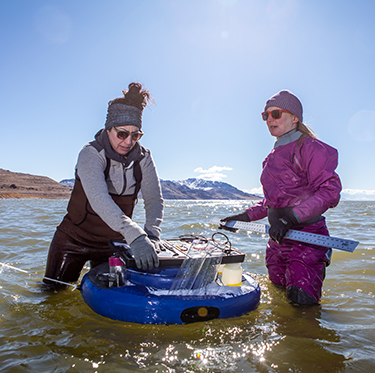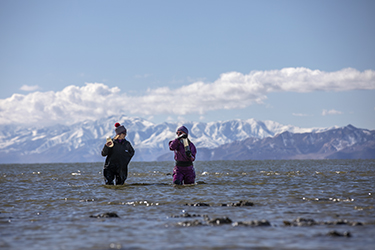‘Our Planet, Your Future’- WSU’s New Environmental Science Degree Launches this Fall
OGDEN, Utah – Students interested in tackling the tough issues facing our planet can now major in environmental science at Weber State University, with the new bachelor's degree available for the fall 2020 semester.
 “Faculty and administration in the College of Science chose to pursue this degree because we are located in a region — and on a planet — with pressing environmental issues, and we have existing strength in environmental sciences across the college with many faculty explicitly trained as environmental scientists,” said Andrea Easter-Pilcher, dean of the College of Science.
“Faculty and administration in the College of Science chose to pursue this degree because we are located in a region — and on a planet — with pressing environmental issues, and we have existing strength in environmental sciences across the college with many faculty explicitly trained as environmental scientists,” said Andrea Easter-Pilcher, dean of the College of Science.
Some of the work currently being conducted in the College of Science includes evaluation of drinking water in Weber County, secondary biomonitoring of heavy metal pollutants in Ogden and recycling electronic waste through mechanochemistry processes.
“A degree in environmental science at Weber State University means students will be able to make a difference in the world we live in,” said John Cavitt, WSU zoology professor. “Students will gain the knowledge and skills needed to work on complex issues related to climate change, sustainability, natural resources and conservation.”
For students who care deeply about the planet and its well-being, the new major is a welcome opportunity. Allison Stanley was the first student to declare environmental science as her degree.
“When Weber State came out with the new environmental science degree, I was able to see many of my interests integrated into one program,” she said. “With a diverse set of prerequisites and four different areas to specialize in, I realized I could take the time to explore many of the different approaches when tackling the climate emergency. I finally feel like I’m given the time and support to help pave the path toward change.”
 The curriculum was developed by a task force headed by department chair Rick Ford and will draw on courses and experts from each of the seven departments in the College of Science. Students can take relevant courses in botany, chemistry, zoology and more, using not only state-of-the-art laboratories on campus, but also natural outdoor laboratories such as Utah’s mountains and the Great Salt Lake.
The curriculum was developed by a task force headed by department chair Rick Ford and will draw on courses and experts from each of the seven departments in the College of Science. Students can take relevant courses in botany, chemistry, zoology and more, using not only state-of-the-art laboratories on campus, but also natural outdoor laboratories such as Utah’s mountains and the Great Salt Lake.
“This interdisciplinary degree is fully supported by all departments in the college and fulfills the desire that many faculty have expressed to work more collaboratively across the college,” Easter-Pilcher said. “The degree is also very well supported across the campus.”
Flexible electives make it possible for students to choose from four different areas of emphasis, including ecology, sustainability and natural resources; environmental health and planning; earth systems and water science; and laboratory, data analysis and workforce skills. Environmental science majors will also have the opportunity to conduct hands-on research on important environmental issues.
.jpg) Graduates from the program will be ready to start their careers in a growing field or move on to graduate studies. Potential employers include public land management agencies, private companies that use natural resources, consulting firms that specialize in environmental issues and colleges and universities conducting high-level environmental research.
Graduates from the program will be ready to start their careers in a growing field or move on to graduate studies. Potential employers include public land management agencies, private companies that use natural resources, consulting firms that specialize in environmental issues and colleges and universities conducting high-level environmental research.
The Bureau of Labor Statistics projects that environmental science jobs will grow by 8% between 2018 and 2028, faster than the average for all occupations in the U.S., and the median annual salary is over $70,000.
The need for environmental scientists will continue to be driven by the increased impact a growing human population has on water quality and quantity, air quality, climate, wildlife habitats, food production, and community susceptibility to natural disasters.
Visit weber.edu/cos/envirosci.html for more information about the environmental science degree.
For photos, visit the following links:
photos.smugmug.com/Press-Release-Photos/2020-photos/June-2020/i-KHqMCv5/0/f4dfe3a7/X2/121317%20Microbiology-X2.jpg
photos.smugmug.com/Press-Release-Photos/2020-photos/June-2020/i-nfcr5Nt/0/331c6cf1/X2/100819%20Chemistry%2011-X2.jpg
photos.smugmug.com/Press-Release-Photos/2020-photos/June-2020/i-3WP4pC8/0/79647e4c/X2/022520%20Great%20Salt%20Lake%20Water%20Science%2029-X2.jpg
photos.smugmug.com/Press-Release-Photos/2020-photos/June-2020/i-8Z8dLQp/0/e87872c7/X2/022520%20Great%20Salt%20Lake%20Water%20Science%2046-X2.jpg
photos.smugmug.com/Press-Release-Photos/2020-photos/June-2020/i-g9jGCWt/0/95a264f4/X2/022820%20Bird%20Banding%2001-X2.jpg
photos.smugmug.com/Press-Release-Photos/2020-photos/June-2020/i-DRzPcsv/0/25f4ba84/X2/031120%20Bird%20Banding%2011-X2.jpg
Visit weber.edu/wsutoday for more news about Weber State University.
Katie England, Web Content Editor
katieengland@weber.edu- Contact:
-
Alicia Miller, College of Science
amiller@weber.edu
-